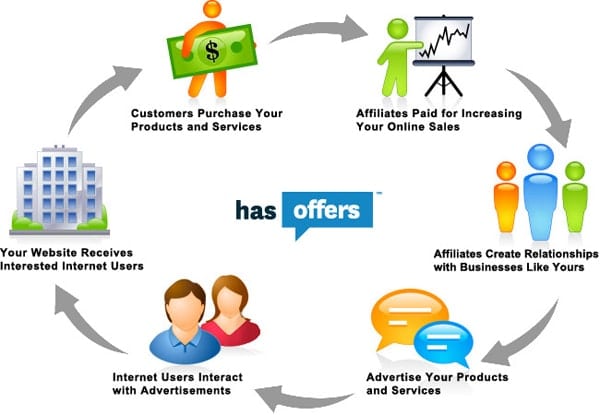What is Affiliate Marketing

The Internet Affiliate marketing is a technique that an advertiser website (affiliator) to promote their products or services by offering compensation to other publishers websites (affiliates) in exchange for a contribution of sales of inscriptions or traffic.
What is the affiliation:
The affiliation is a partnership between a website editor and a commercial site seeking to increase sales online or pick up a larger number of quote requests. The commercial site, then called "advertiser" offers an affiliate program site wishing to monetize their traffic, so called "affiliate". This affiliate program describes how the affiliate will be compensated by promoting products or services affiliators. The modes of an affiliate program compensation can be varied, they may include any or all of the following modes:
CPA (Cost Per Action or earnings per share): eg a commission on a purchase
CPL (Cost Per Lead or pay per form): eg a credit application, a subscription to a newsletter ...
CPC (Cost per click or pay per click): example, a click on a banner or text link
The e-commerce sites use affiliate networks to make available to their members text links, banners, and product catalogs. These products are used by catalogs comparison websites, and the actors of retargeting.
When several members were actors on a sale, the affiliate company attributes the sale to one of the affiliates according to the rules set by the publisher (usually there is attribution to the last click).
The beginning of the affiliation:
It appeared in 1996 in the US with the Amazon affiliate program, it is indeed the latter has been for the first time the idea of paying other sites to promote his books. The exchange was simple: to advise our books your visitors and you will earn commission. From 2000 pure players have consistently opened affiliate programs, usually through platform. It was not until the resumption of investment on the Internet in 2004 to see the arrival of the big names in the world of affiliation.
To increase traffic and therefore revenue for e-commerce sites, some dealers have offered to webmasters whose sites were well positioned on search engines to display their products in exchange for a commission on sales generated . Other sites use to purchase PPC to drive traffic on their own site before returning it to the sites of affiliators. Still others, constitute the foundations of hundreds of thousands of subscribers to their newsletters, to which they relay the promotional offers of affiliators.
The technique appeared in France in 1999. But it was not until about five years before the share of sales generated by the affiliate becomes an important source of traffic for hundreds of commercial sites.
The field of membership in France is an area where hundreds or even thousands of French and foreign players share the market.
It is impossible to precisely the "figures of membership" as the French site publishers are working with both foreign affiliate programs (Amazon, Google AdSense, template monster for example) and French and some services Affiliate not reveal their country figures often for reasons of protection against competition.
In France, a collective affiliate platforms (CPA) was established in February 2009 by the largest platforms representing 90% of the market in France platforms: Commission Junction, Tradedoubler, zanox, affilinet Effiliation, Netaffiliation, Public-Ideas , ReactivPub and Webgains. The goal is to redefine the rules of sector between affiliates, advertisers and platforms. In 2014, this group was renamed collective performance and the acquisition and welcomes new members.
A form commonly used by affiliate white label services, thus has a hundred white markings on the French plan in various sectors.

Issues of membership:
If the technique of affiliation allows a multitude of websites to relay a targeted offer, it is also the source of great shops.
Commissions paid by webmarchands Webmasters vary: pay per click (a few cents per click), sales commissions (fixed or variable) or act (lead). Hybrid models (pay per click and sales commissions or act) exist and are intended to motivate affiliates. A capping can be practiced to minimize click fraud and enhance the performance of the affiliate program: X clicks for sale. Secondly, the most important affiliates (top affiliates) may obtain specific compensation conditions.
In practice webmarchands make available to webmasters, advertising visuals or product catalogs in various formats (XML, txt, csv) or communicate how to rewrite their URLs to include the "tag" the webmaster and redirect the user to Product Page, dependent for them to integrate on their site. The affiliator must also conduct its program to make it attractive: the challenges reward the best affiliates or temporary increases in commission and are frequently used.
Webmasters regularly receive their commissions on the basis of test reports merchants or platforms. However the visitors into buyers transformation ratios rarely reach more than 1% on average. Nevertheless, membership is an effective marketing tool performance and allows the affiliator obtain increased visibility by limiting costs.
There are still very few precise data on the affiliate market in Europe. SRI (Union governed internet) regularly publishes figures for advertising expenditure on the Internet: the first half of 2010, the affiliation accounted for 8% of advertising investments on the internet, making affiliation 4th kind of Internet advertising investment in France behind the directories (20%), the "display" (22%) and "search" (37%).
For better understanding do not hesitate to contact us on: lhoussin5@gmail.com
I would be very happy to answer your questions.

Aucun commentaire:
Enregistrer un commentaire